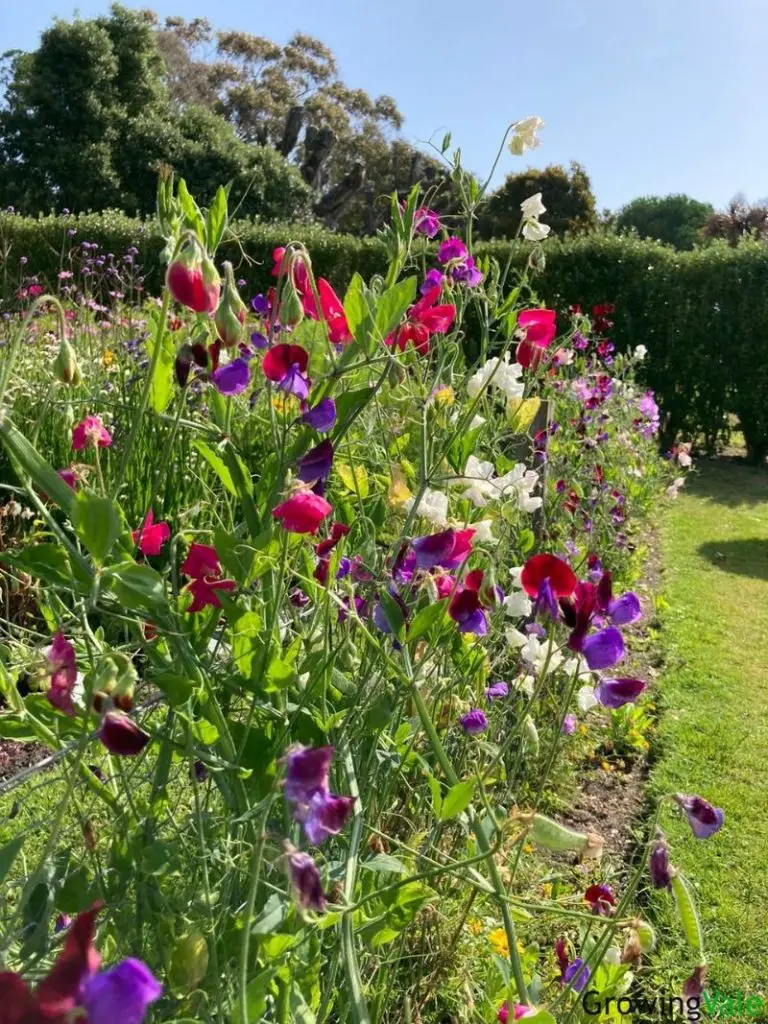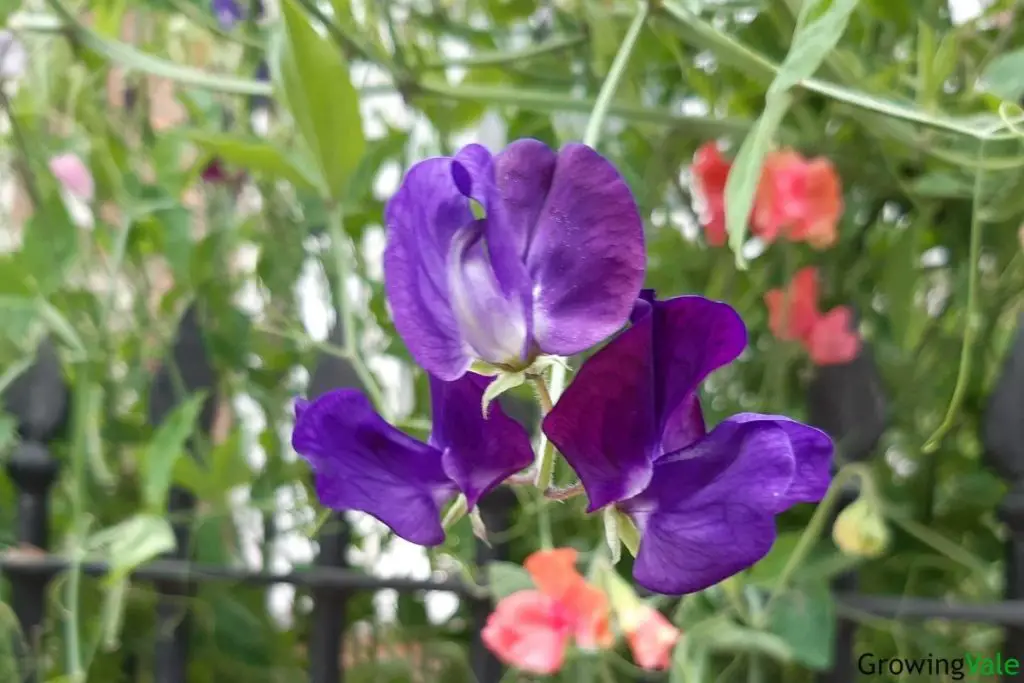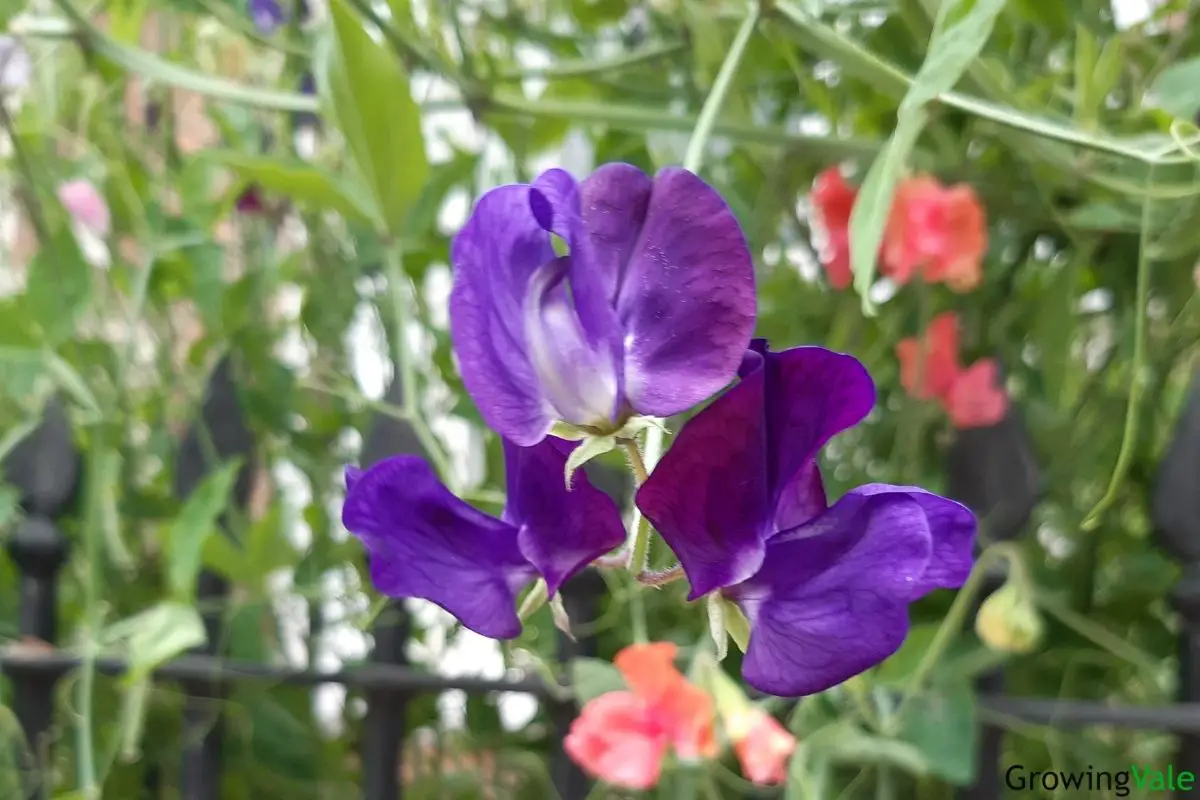Sweet Peas or Lathyrus odoratus are beautiful annuals that belong to the genus Lathyrus which contains roughly 160 species of flowering plants. They are part of the legume family Fabaceae, and are related to the edible pea which also belongs to the Fabaceae group!
These plants are familiar favorites, particularly for growers with cottage-style or informal gardens. Their delicate and fragrant flowers bring life to any space and are easily grown year after year. They either form bushy mounds or can be trained as climbers, and look particularly delightful tumbling over a garden fence!
History
Native to Crete, Italy, and the island of Sicily, sweet peas are said to have been brought to attention by a Franciscan monk named Father Cupani. He first discovered the sweet pea flower in 1696 while wandering the hills of Sicily, and was so captivated by its glorious violet and deep red color, and sweet fragrance that he brought it back and planted it in his monastery garden.
In 1699 he shipped it to a friend in Britain and by 1724 the plant was commercially available under the name “Cupani’s Original”. Since then, growers have greatly expanded the colors, characteristics, and sizes of the original plant, leading to hundreds of magnificent varieties.
To this day, breeders are still trying to cultivate a yellow sweet pea variety, which is proving to be as elusive as the highly sought-after blue Rose.
There is a huge selection of charming plants to choose from, with colors ranging from pink, red, white, orange, blue, purple, or a combination. They can have different-sized blooms, have “wavy” petals, and vary in the strength of their scent. Nevertheless, all varieties are truly lovely and would make a great addition to any garden!
Plant Facts
| Scientific name | Lathyrus odoratus |
| Common names | Sweet Pea |
| Genus | Lathyrus |
| Family | Fabaceae |
| Height | 3 ft. 0 in. – 8 ft. 0 in. |
| Width | 2 ft. 0 in. – 3 ft. 0 in. |
| USDA Plant Hardiness Zone | 2 – 11 |
| Origin | Crete, Italy, Sicily |
| Flower colors | Red, Pink, Purple, Blue, Orange, White, Multi-colored |
| Blooming season | Late-winter – Summer |
| Plant/Flower special features | Fragrant flowers |
How to Plant and Grow Sweet Pea Flowers
When planting sweet pea bushes or vines, choose an area that meets the soil and light requirements for them to thrive. If growing these annuals yearly, try to avoid planting them in the same spot over consecutive years.

Growing Sweet Peas in a Bed
These plants can be purchased easily from nurseries or garden centers, so either use readily available plants or those started from seed. Prepare the garden bed ideally one month before planting by amending it with manure or garden compost. Some general-purpose fertilizer can also be added onto the area following the recommended dosage.
Wait until one month before the last frost to transplant the sweet pea seedlings in the garden, they are hardy plants so a little light frost shouldn’t be a problem. Those sown inside will need to be hardened off 10-14 days before transplanting. Remove the seedlings gently from the pots, watering beforehand can help make this easier, before planting them in holes dug in the garden. Water well immediately to settle in.
For purchased plants, a little extra care is required. Before planting, remove any flowers or buds to allow the roots to become more established. A larger plant with an abundance of bigger blooms will be the reward later! Make sure to keep the root ball intact when removing it from the original container, and plant it at the same depth at which it was previously growing. Lightly pat down the soil and water. Wait at least a week before mulching.
Space climbing types at least 6 inches apart, and dwarf, bushy varieties a minimum of 12 inches apart. Plant sweet peas 2-3 inches away from any structures they’re intended to climb such as trellises or fences, or for long vines that will require support, 2-3 inches from their stakes.
Growing Sweet Peas in a Pot
Bushy dwarf varieties and climbing types are suitable as container plants. To maximize success, choose a container that is at least 18 inches deep with sufficient drainage.
Either transplant existing plants using the above recommendations, or sow seeds directly. In this case, sow seeds 0.5 inches deep, in a ring at least 1-inch from the rim of the container, and spaced 1-inch apart from each other. It is easiest to install the support first and sow the seeds around.
Use a rich, loam-based compost for planting, and bear in mind that container plants will need extra watering and increased fertilization.

How to Propagate Sweet Pea Plants
These plants are generally grown from seed and perform the best when started during cooler temperatures. They can be directly sown in the ground or started in pots, however, generally, those started in pots have a higher success rate. Purchase seeds or use those collected from the previous year’s plant.
In areas with warm winters, sweet pea seeds can be directly sown as early as November – December for late winter to spring blooming. In more harsh winter climates, start seeds off indoors in January-March, and plant them out in April for a summer blooming. In April they can be directly sowed.
Prepare the seeds by placing them between a layer of wet kitchen paper, inside an airtight container in a warm room. Sow them once you see signs of swelling or if they have sprouted. Alternatively, soak the seeds overnight, but these will require immediate sowing the next morning or risk rotting. Nick the outside of seeds that have not swollen or sprouted to aid germination.
Sowing Directly in Beds
When sowing seeds directly into beds, amend the soil following the guidelines for bed planting and place the seeds in a row, 1-inch deep and spaced 2-3 inches apart. Put any required support into the ground before sowing, and plant the seeds 2-3 inches away. This also applies to structures such as fences and trellises if the plants are intended as climbers.
Once sweet pea seedlings have at least two true pairs of leaves, thin them out to at least 6 inches apart for dwarf varieties, and 12 inches for climbing vines.
Sowing in Containers
Sow sweet pea seeds individually in root trainers or 3-inch pots with seed compost, planted ½ an inch deep, or, sow 5-7 seeds in a 5-inch pot spaced 1-inch apart. Alternatively, you could sow them directly into their final containers following the spacing guidelines suggested earlier.
After sowing, water them well to settle in and keep the containers at 59°F. Cover seeds with a plastic cover to lower the risk of them drying out, but make sure to remove them after germination. This will increase the success rate but isn’t necessarily mandatory.
Seeds sown several to a pot can be transplanted once they reach 1.5 inches tall into individual 3-inch pots. Once seedlings are 3-4 inches high, pinch them back to just above a healthy leaf to encourage branching. Plant them out once the danger of frost has passed.

Care and Maintenance
Here are some sweet pea care tips to get the most out of your plant:
Soil
They prefer rich, organic, well-draining soils with medium moisture. They do best in cool soils, so mulching is recommended.
Water
Flowering will suffer under dry conditions so it is recommended to check the soil every 3-4 days during dry, hot weather, and water as required. This involves thoroughly soaking the ground so the entire depth of the root gets water. For those grown in containers, check the soil every day.
In very dry conditions, plants will also benefit from a light spray over with water. However, be wary of overwatering as they may rot in overly wet conditions.
Fertilizer
On infertile and light soil types, plants will benefit from a weekly or fortnightly feeding with a high potassium liquid fertilizer.
Sunlight
They must be in a sunny area, full sun is best, as under shady conditions flower buds will not form. They can tolerate a little light shade. Planting them in a south-facing position is ideal.
Seedlings can become leggy if they have insufficient light and are too warm, move them to a cooler, brighter area if this happens.
Temperature and Humidity
They are hardy to USDA zones 2-11, but for them to bloom to their full potential, they require around 50 days of cool temperatures below 60°F. Above 86°F flowering will suffer, but it should improve once temperatures cool down.
Pest and diseases
These plants are prone to pests and some diseases, but none of them pose a serious problem. Watch out for aphids and protect young plants in particular from snails and slugs.
They are prone to powdery mildew, so make sure to space them out when planting, and water them early in the day to lower the risk of fungal problems.
Some plant viruses are known to attack sweet pea plants, but this isn’t a common occurrence.
Pruning
Deadhead spent flowers to redirect energy into producing more blooms and not to creating seed pods. These plants may readily self-seed, so deadheading plants is recommended as sweet pea vines shouldn’t be planted in the same spot over consecutive years.
To harvest seeds for the following year, allow the seed pods to develop, extract the seeds from the dried pods and store them in an airtight container in a cool, dry place.
Toxicity
Unlike their cousins the edible peas, sweet pea fruits are inedible and toxic to people. If consumed in large quantities, they can cause a condition described as Lathyrus which causes labored breathing, convulsions, and paralysis.
Uses of Sweet Pea Flower
Sweet peas are extremely popular ornamental plants and are garden favorites! Use them as beautiful cut flowers for your home or as bouquets. These plants are so admired there are several groups devoted to dispensing knowledge and hosting exhibitions, such as the National Sweet Pea Society which was founded in 1900 in the UK.
They are the core ingredient in the production of sweet pea essential oil, which is prized for its fragrance and used in perfume blends.
Common Varieties and Cultivars
Here are some beautiful sweet pea varieties and cultivars:
- Apricot Queen – Apricot Queen is a strongly fragrant, Spencer Sweet Pea variety. It is a climbing variety reaching up to 8 feet, and would look lovely on a trellis in a cottage-style garden! Blooms are a soft apricot color, with delicately waved petal edges.
- Cupani – An heirloom variety, and the same plant that Father Cupani found in Sicily, Cupani has wonderful bi-colored crimson and violet blooms. This is a vigorous climber reaching 8 feet in height. Its flowers are noticeably smaller than other varieties, but their wonderful scent more than compensates!
- Dorothy Eckford – This plant has large and magnificent white blooms that reach 2 inches across! A Grandiflora type first introduced in 1903, it has a lovely fragrance which makes it ideal for cut flowers in the home. This climbing type reaches as high as 6 feet.
- Lord Nelson – An introduction from the 1890s, Lord Nelson is a vigorous climber growing as large as 8 feet. It has beautiful blue-violet blooms that are delightfully fragrant and was named in honor of Admiral Lord Nelson of the British Royal Navy.
- Senator – Senator reaches 8 feet high and has creamy-white petals decorated with brown-purple flakes. Flowers are usually produced in groups of 2-3 blooms per stem. An heirloom plant from 1891, this plant proves to be as popular today as ever!
Conclusion
Sweet peas are popular flowering annuals that belong to the Fabaceae family. Another well-known member of this legume family is the edible pea, a common food crop. They have beautiful, fragrant flowers, and have a growing habit either as climbing vines or bushy mounds.
They are native to parts of the Mediterranean and were first discovered by a monk called Father Cupani who found them in the hills of Sicily. In the late 1600s he sent the plant to Britain to a friend and by 1724 sweet peas became available commercially.
Sweet pea flowers come in many lovely colors and are relatively easy to grow plants that are perfect for cottage-style gardens. Train them for trellises and fences or grow them in containers to brighten up your outdoor space.
Up next: Sweet Pea Flower Meaning and Symbolism

